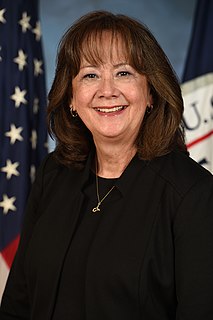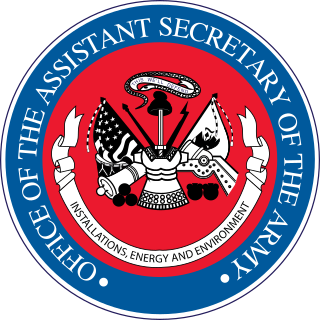
The United States secretary of the interior is the head of the United States Department of the Interior. The secretary and the Department of the Interior are responsible for the management and conservation of most federal land along with natural resources, leading such agencies as the Bureau of Land Management, the United States Geological Survey, Bureau of Indian Affairs, and the National Park Service. The secretary also serves on and appoints the private citizens on the National Park Foundation Board. The secretary is a member of the United States Cabinet and reports to the president of the United States. The function of the U.S. Department of the Interior is different from that of the interior minister designated in many other countries.

The United States Department of Energy (DOE) is a cabinet-level department of the United States government concerned with matters of federal energy policy and the safe handling of nuclear material. The DOE is responsible for the U.S. nuclear weapons program, nuclear reactor production for the United States Navy, energy-related research, and domestic energy production and energy conservation.

The Strategic Petroleum Reserve (SPR) is an emergency stockpile of petroleum maintained by the United States Department of Energy (DOE). It is the largest known emergency supply in the world, and its underground tanks in Louisiana and Texas have capacity for 714 million barrels (113,500,000 m3). The United States started the petroleum reserve in 1975 after oil supplies were interrupted during the 1973–1974 oil embargo, to mitigate future supply disruptions.

The secretary of the Army is a senior civilian official within the United States Department of Defense, with statutory responsibility for all matters relating to the United States Army: manpower, personnel, reserve affairs, installations, environmental issues, weapons systems and equipment acquisition, communications and financial management.

FutureGen was a project to demonstrate capture and sequestration of waste carbon dioxide from a coal-fired electrical generating station. The project (renamed FutureGen 2.0) was retrofitting a shuttered coal-fired power plant in Meredosia, Illinois, with oxy-combustion generators. The waste CO2 would be piped approximately 30 miles (48 km) to be sequestered in underground saline formations. FutureGen was a partnership between the United States government and an alliance of primarily coal-related corporations. Costs were estimated at US$1.65 billion, with $1.0 billion provided by the Federal Government.

The energy policy of the United States is determined by federal, state, and local entities in the United States, which address issues of energy production, distribution, and consumption, such as building codes and gas mileage standards. Energy policy may include legislation, international treaties, subsidies and incentives to investment, guidelines for energy conservation, taxation and other public policy techniques.

The Under Secretary of the Treasury for International Affairs is a senior position within the United States Department of the Treasury responsible for advising the Secretary of the Treasury on international economic issues. During the Trump Administration the office was held by Brent McIntosh following the appointment of David Malpass to lead the World Bank. As of June 2021, the office is vacant.

The Under Secretary for Science and Innovation, formerly the Under Secretary for Science and Energy, is a high-ranking position within the United States Department of Energy. The position was created by the Energy Policy Act of 2005, and the first Under Secretary for Science, Raymond L. Orbach, was sworn in on June 1, 2006. The under secretary is appointed by the President of the United States and confirmed by the United States Senate. In March 2009, Steven E. Koonin was nominated to replace Orbach. Franklin (Lynn) M. Orr was sworn in as the Under Secretary for Science and Energy on December 17, 2014, and served in this position through the end of the Obama administration. The most recent under secretary was Paul Dabbar.
The Office of Energy Efficiency and Renewable Energy (EERE) is an office within the United States Department of Energy. Formed from other energy agencies after the 1973 energy crisis, EERE is led by the Assistant Secretary of Energy Efficiency and Renewable Energy, who is appointed by the President of the United States and confirmed by the U.S. Senate. Kelly Speakes-Backman was appointed Acting Assistant Secretary in January 2021.

The United States produced 6.6 billion metric tons of carbon dioxide equivalent greenhouse gas (GHG) emissions in 2019, the second largest in the world after greenhouse gas emissions by China and among the countries with the highest greenhouse gas emissions per person. In 2019 China is estimated to have emitted 27% of world GHG, followed by the United States with 11%, then India with 6.6%. In total the United States has emitted a quarter of world GHG, more than any other country. Annual emissions are over 15 tonnes per person and, amongst the top eight emitters, is the highest country by greenhouse gas emissions per person. Because coal-fired power stations are gradually shutting down, in the 2010s emissions from electricity generation fell to second place behind transportation which is now the largest single source. In 2019, 29% of the GHG emissions of the United States were from transportation, 25% from electricity, 23% from industry, 13% from commercial and residential buildings and 10% from agriculture. These greenhouse gas emissions are contributing to climate change in the United States as well as worldwide.

The Under Secretary of Energy for Infrastructure, previously the Undersecretary for Energy, is a position within the United States Department of Energy. The under secretary oversees the department's energy and environment programs, including environmental cleanup of the nuclear weapons complex, nuclear waste management efforts, and applied energy research and developmental activities.

Dennis Ray Spurgeon is a former Assistant Secretary for Nuclear Energy within the United States Department of Energy. He was sworn in on April 3, 2006, becoming the most senior nuclear technology official in the American government. In addition, he is the leader of the Global Nuclear Energy Partnership, a strategy aimed at accelerating the demonstration of a more proliferation resistant closed fuel cycle and reducing the possibility that nuclear energy could be used for non-peaceful purposes. In his capacity as Assistant Secretary, he has previously served as Acting Under Secretary of Energy for Energy and Environment.

Jeffrey D. Jarrett was the Assistant Secretary for Fossil Energy within the United States Department of Energy, from his swearing in on January 3, 2006 until March 2007. Until his appointment to the position, he had served as director of the Department of the Interior's Office of Surface Mining. He was sworn into that position on February 12, 2002. In March 2007, the Coal-Based Generation Stakeholders announced Jeffrey Jarrett would join them as its executive director.

Karen S. Evans is a former United States Senate confirmed, Presidential Appointed executive, who served as the first Assistant Secretary for Cybersecurity, Energy Security and Emergency Response at the U.S. Department of Energy. An executive who served in three Presidential Appointed positions in two Administrations.
The Office of Science is a component of the United States Department of Energy (DOE). The Office of Science is the lead federal agency supporting fundamental scientific research for energy and the Nation’s largest supporter of basic research in the physical sciences. The Office of Science portfolio has two principal thrusts: direct support of scientific research and direct support of the development, construction, and operation of unique, open-access scientific user facilities that are made available for use by external researchers.
Carl Michael "Mike" Smith is an American businessman, energy expert, and politician from Oklahoma. Smith is currently serving as the Executive Director of the Interstate Oil and Gas Compact Commission. Smith has served in numerous energy policy positions for both the United States federal and Oklahoma state governments, including Assistant Secretary of Energy for Fossil Energy under President George W. Bush (2002–2004) and Oklahoma Secretary of Energy under Governor of Oklahoma Frank Keating (1995–2002).
The Texas Clean Energy Project (TCEP) was a project developed by Summit Power Group, Inc intended to build of the world’s first Integrated Gasification Combined Cycle (IGCC) clean-coal power plant, a type of carbon capture and storage facility, located near Odessa, Texas.

The Assistant Secretary of the Army for Installations, Energy and Environment is a civilian office within the United States Department of the Army.
The Office of Nuclear Energy (NE) is an agency of the United States Department of Energy which promotes nuclear power as a resource capable of meeting the energy, environmental, and national security needs of the United States by resolving technical and regulatory barriers through research, development, and demonstration.













